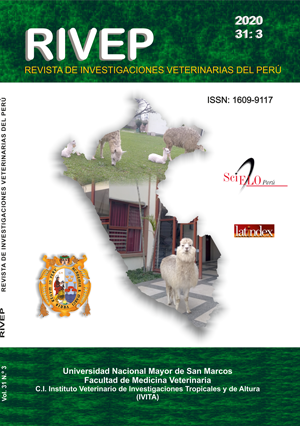Knowledge and potentially risk practices in animal ownership related to exposure to zoonoses in the Lomas de Carabayllo Sector, Lima – Peru
DOI:
https://doi.org/10.15381/rivep.v31i3.18170Keywords:
animals of company, zoonosis, possession, rabies, dogs, catsAbstract
The objective of the study was to describe animal ownership, knowledge and potentially risk practices related to exposure to zoonotic infections among residents of the San Benito Human settlement, Carabayllo (Lima, Peru). In total, 394 people were surveyed, of which 55.6 and 32.2% of them owned cats and dogs, respectively. One dog was found for every 4.6 people and one cat for every 8.5 people. The estimated life expectancy for dogs was 3.3 years and for cats 3.1 years, being their main utility as companion animal. Among dog owners, 88.6% reported the animals were vaccinated against rabies; 39.9 and 35.6% treated their dog against external and internal parasites, respectively, and with the appropriate frequency (every 3 months approx.); 23.5% performed reproductive control (spay/neuter); 78.7% mentioned that stray dogs represent a problem and 57.9% considered that they had an owner; 22.6% said they have had at least one family member bitten by a dog, resulting in a rate of 5.9% (98/1651) in the study population. Of these, 65.2% mentioned that the dog was not vaccinated or did not know whether they were vaccinated, and 55.1% stated that the injured person resorted to a health service for attention. Moreover, 65.0% said they know of diseases that are transmitted from animals to people. Poultry, rabbits, and guinea pigs were the animals that were raised most frequently in the backyard, mostly for self-consumption. The study offers a baseline for the application of population control and animal ownership programs in this population.
Downloads
Downloads
Published
Issue
Section
License
Copyright (c) 2020 Bianca Esparza Juárez, Daphne León Córdova, Néstor Falcón Pérez

This work is licensed under a Creative Commons Attribution-NonCommercial-ShareAlike 4.0 International License.
AUTHORS RETAIN THEIR RIGHTS:
a. Authors retain their trade mark rights and patent, and also on any process or procedure described in the article.
b. Authors retain their right to share, copy, distribute, perform and publicly communicate their article (eg, to place their article in an institutional repository or publish it in a book), with an acknowledgment of its initial publication in the Revista de Investigaciones Veterinarias del Perú (RIVEP).
c. Authors retain theirs right to make a subsequent publication of their work, to use the article or any part thereof (eg a compilation of his papers, lecture notes, thesis, or a book), always indicating the source of publication (the originator of the work, journal, volume, number and date).










